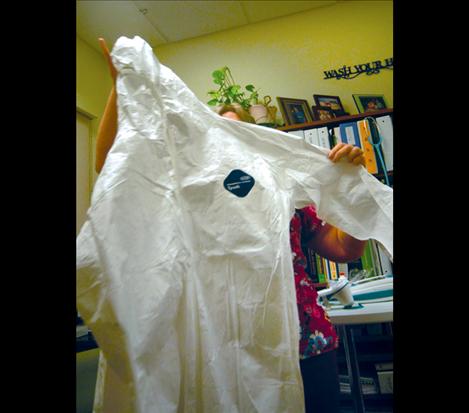Area hospitals, emergency workers train for Ebola
Hey savvy news reader! Thanks for choosing local.
You are now reading
1 of 3 free articles.
Ebola.
The very word sounds menacing, but then the disease is defined – an infectious and generally fatal disease marked by fever and severe internal bleeding, which is spread through contact with infected body fluids by a filovirus.
Rest assured, local medical and emergency workers are preparing in case a person in the Mission Valley contracts the Ebola virus. At a special meeting Nov. 5, they discussed just such a scenario.
Steve Stanley from Lake County Office of Emergency Management said that his office would immediately enact their emergency operations plan.
Lake County’s emergency operations plan identifies and assigns disaster responsibilities for natural and man-caused disasters.
Stanley said his office would also work to keep Lake County’s commissioners in the loop. If an Ebola case were to present itself, the Lake County Health Department would be in financial trouble almost immediately, and commissioners would have to find some money or enact a two mil levy to pay the tab.
Area hospitals, Providence St. Joseph’s Medical Center and St. Luke Community Hospital, are responsible for the care of an Ebola patient until the State of Montana or the United States Center for Disease Control decides where that patient is to be sent.
Donna McDaniel, assistant director of nursing and infection control nurse at St. Luke Hospital, said the hospital has re-educated their staff since the Ebola breakout in West Africa.
Education centers on “donning and doffing” hazardous materials suits, doubling booties and double gloving. An observer is on hand to watch changing Hazmat suits to make sure there is no touching or contamination, according to McDaniel. Providence St. Joseph’s nursing staff has also had training.
Kate Hurley, intensive care nursing director for St. Patrick Hospital, Missoula, had spent 20 days in a Sierra Leone Ebola ward working with Dr. George Risl, an infectious disease specialist from Missoula. Risl and Hurley worked at a clinic caring for as many as 95 patients at a time.
Hurley and Tammy Powers, certified infection prevention coordinator, gave a workshop on “donning and doffing” — how to wear PPE, how to take it on and off. Taking it off is the hard part, said Erin Rumelhart, Providence St. Joseph’s director of nursing. The group also talked about the fact that it’s resource intensive to take care of an Ebola patient.
With only seven emergency room nurses, Rumelhart said they’d go through staff quickly.
In the rare event of an Ebola patient, St. Luke’s emergency wing will become an isolation unit.
“When we do training, we tell staff ‘It’s about protecting you and keeping you safe,’” McDaniel said. “The nurse is responsible for all the care of an Ebola patient, so it’s pretty intense.”
The recommendation is for nurses to trade off every two to two and a half hours, since Hazmat suits are hot.
“Ebola is a rare and deadly virus,” she said. “Flu is much more common … we use personal protection in the same way. We just enhance it for Ebola.”
Part of the education for the emergency staff of both hospitals is asking of assessment questions.
They target certain areas in West Africa, such as Sierra Leone, Rumelhart explained.
Staff routinely ask: “Have you traveled to Africa? Have you been in contact with people who have traveled to Africa in the last 20 days? Have you had a fever of 100.4 degrees, vomiting, diarrhea or petechiae (small red or purple spots on the skin)?”
Based on these questions, a patient is classified as either high-risk or not. A high-risk patient is immediately masked.
At St. Joe’s they keep a cart of personal protection equipment in a central locale, “where it is easy for the nurses to grab,” Rumelhart said. They also have a procedure to transport a patient to a decontamination room.
People are concerned about the way Ebola is spread.
“It’s spread by (bodily fluid) that’s wet,” McDaniel said, including coughs, sneezes, tears and even sweat.
As a side note, McDaniel said it’s surprising how many people regularly travel to Africa or visit relatives in Africa.
Health care, emergency services, the OEM and law enforcement have scheduled a tabletop exercise in December to discuss what each department would do in the event the Ebola virus is discovered locally.
“It’s a great opportunity to talk about infection control,” Stanley said.
The CDC website defines Ebola virus, lists signs and symptoms, talks about transmission and lists all of the current outbreaks.
Visit www.cdc.gov/vhf/Ebola, for the most current information.
















